Effect of Reactive Oxygen Species Photoproduced in Different Water Matrices on the Photostability of Gadusolate and Mycosporine-Serinol
Abstract
1. Introduction
2. Results and Discussion
2.1. Properties of Matrices
2.2. Stability in Different Water Matrices
2.2.1. Experiments Using Dark Controls
2.2.2. Solar Irradiation
2.2.3. Selective Reaction with Photosensitizers
3. Materials and Methods
3.1. Biomolecules, Chemicals and Reagents
3.1.1. Mycosporine-Serinol and Gadusol
3.1.2. Matrices
3.1.3. Photosensitizers
3.2. Determination of Singlet Oxygen Steady State Concentration in Natural Matrices
3.3. Decomposition Experiments
3.3.1. Solar Irradiation
3.3.2. Dark Controls
3.4. Photodegradation Quantum Yield Determination
3.5. Statistical Analysis
4. Conclusions
Author Contributions
Funding
Data Availability Statement
Acknowledgments
Conflicts of Interest
References
- Oren, A.; Gunde-Cimerman, N. Mycosporines and mycosporine-like amino acids: UV protectants or multipurpose secondary metabolites? FEMS Microbiol. Lett. 2007, 269, 1–10. [Google Scholar] [CrossRef] [PubMed]
- Bhatia, S.; Garg, A.; Sharma, K.; Kumar, S.; Sharma, A.; Purohit, A.P. Mycosporine and mycosporine-like amino acids: A paramount tool against ultra violet irradiation. Pharmacogn. Rev. 2011, 5, 138–146. [Google Scholar] [CrossRef] [PubMed]
- Kageyama, H.; Rungaroon, W.-S. Mycosporine-like amino acids as multifunctional secondary metabolites in cyanobacteria: From biochemical to application aspects. Stud. Nat. Prod. Chem. 2018, 59, 153–194. [Google Scholar]
- Parailloux, M.; Godin, S.; Fernandes, S.C.M.; Lobinski, R. Untargeted analysis for mycosporines and mycosporine-like amino acids by hydrophilic interaction liquid chromatography (HILIC)—Electrospray orbitrap MS2/MS3. Antioxidants 2020, 9, 1185. [Google Scholar] [CrossRef]
- Mishra, R.; Kaur, P.; Soni, R.; Madan, A.; Agarwal, P.; Singh, G. Decoding the photoprotection strategies and manipulating cyanobacterial photoprotective metabolites, mycosporine-like amino acids, for next-generation sunscreens. Plant Physiol. Biochem. 2024, 212, 108744. [Google Scholar] [CrossRef]
- McReynolds, C.; Adrien, A.; Silvestre de Ferron, A.; Pecastaing, L.; Boussetta, N.; Grimi, N.; Fernandes, S.C.M. Extraction of mycosporine-like amino acids and proteins from the Agarophyte Gelidium corneum using pulsed power techniques. Foods 2023, 12, 1473. [Google Scholar] [CrossRef]
- Gigena Carvalho, P.; Isla Naveira, R.; Granone, L.I.; Mendive, C.B.; Massa, A.E.; Churio, M.S. A comparative review of natural and synthetic UV filters: Gadusol and benzophenone-3 as representative examples. Environ. Adv. 2023, 13, 100404. [Google Scholar]
- Bandaranayake, W. Mycosporines: Are they nature’s sunscreens? Nat. Prod. Rep. 1998, 15, 159–172. [Google Scholar] [CrossRef]
- Shick, J.M.; Dunlap, W.C. Mycosporine-like amino acids and related gadusols: Biosynthesis, accumulation, and UV-protective functions in aquatic organisms. Annu. Rev. Physiol. 2002, 64, 223–262. [Google Scholar] [CrossRef]
- Nohynek, G.J.; Dufour, E.K. Nano-sized cosmetic formulations or solid nanoparticles in sunscreens: A risk to human health? Arch. Toxicol. 2012, 86, 1063–1075. [Google Scholar] [CrossRef]
- Morabito, K.; Shapley, N.C.; Steeley, K.G.; Tripathi, A. Review of sunscreen and the emergence of non-conventional absorbers and their applications in ultraviolet protection. Int. J. Cosmet. Sci. 2011, 33, 385–390. [Google Scholar] [CrossRef] [PubMed]
- Sánchez-Quiles, D.; Tovar-Sánchez, A. Are sunscreens a new environmental risk associated with coastal tourism? Environ. Int. 2015, 83, 158–170. [Google Scholar] [CrossRef] [PubMed]
- MacManus-Spencer, L.A.; Tse, M.L.; Klein, J.L.; Kracunas, A.E. Aqueous photolysis of the organic ultraviolet filter chemical octyl methoxycinnamate. Environ. Sci. Technol. 2011, 45, 3931–3937. [Google Scholar] [CrossRef]
- Wada, N.; Sakamoto, T.; Matsugo, S. Mycosporine-like amino acids and their derivatives as natural antioxidants. Antioxidants 2015, 4, 603–646. [Google Scholar] [CrossRef] [PubMed]
- Favre-Bonvin, J.; Arpin, N.; Brevard, C. Structure de la mycosporine (P 310). Can. J. Chem. 1976, 54, 1105–1113. [Google Scholar] [CrossRef]
- Fernandes, S.C.M.; Alonso-Varona, A.; Palomares, T.; Zubillaga, V.; Labidi, J.; Bulone, V. Exploiting mycosporines as natural molecular sunscreens for the fabrication of UV-absorbing green materials. ACS Appl. Mater. Interfaces 2015, 7, 16558–16564. [Google Scholar] [CrossRef]
- Grant, P.T.; Plack, P.A.; Thomson, R.H. Gadusol, a metabolite from fish eggs. Tetrahedron Lett. 1980, 21, 4043–4044. [Google Scholar] [CrossRef]
- Plack, P.A.; Fraser, N.W.; Grant, P.T.; Middleton, C.; Mitchell, A.I.; Thomson, R.H. Gadusol, an enolic derivative of cyclohexane-1,3-dione present in the roes of cod and other marine fish Isolation, properties and occurrence compared with ascorbic acid. Biochem. J. 1981, 199, 741–747. [Google Scholar] [CrossRef] [PubMed]
- Roullier, C.; Chollet-Krugler, M.; Bernard, A.; Boustie, J. Multiple dual-mode centrifugal partition chromatography as an efficient method for the purification of a mycosporine from a crude methanolic extract of Lichina pygmaea. J. Chromatogr. B 2009, 877, 2067–2073. [Google Scholar] [CrossRef]
- De la Coba, F.; Aguilera, J.; Korbee, N.; de Gálvez, M.V.; Herrera-Ceballos, E.; Álvarez-Gómez, F.; Figueroa, F.L. UVA and UVB Photoprotective capabilities of topical formulations containing mycosporine-like amino acids (MAAs) through different biological effective protection factors (BEPFs). Mar. Drugs 2019, 17, 55. [Google Scholar] [CrossRef]
- Arbeloa, E.M.; Bertolotti, S.G.; Churio, M.S. Photophysics and reductive quenching reactivity of gadusol in solution. Photochem. Photobiol. Sci. 2011, 10, 133–142. [Google Scholar] [CrossRef] [PubMed]
- Orallo, D.E.; Lores, N.J.; Arbeloa, E.M.; Bertolotti, S.G.; Churio, M.S. Sensitized photo-oxidation of gadusol species mediated by singlet oxygen. J. Photochem. Photobiol. B Biol. 2020, 213, 112078. [Google Scholar] [CrossRef] [PubMed]
- Bernillon, J.; Parussini, E.; Letoublon, R.; Favre-Bonvin, J.; Arpin, N. Flavin-mediated photolysis of mycosporines. Phytochemistry 1990, 29, 81–84. [Google Scholar] [CrossRef]
- Kulthanan, K.; Nuchkull, P.; Varothai, S. The pH of water from various sources: An overview for recommendation for patients with atopic dermatitis. Asia Pac. Allergy 2013, 3, 155–160. [Google Scholar] [CrossRef]
- Mosley, L.M.; Peake, B.M.; Hunter, K.A. Modelling of pH and inorganic carbon speciation in estuaries using the composition of the river and seawater end members. Environ. Model. Softw. 2010, 25, 1658–1663. [Google Scholar] [CrossRef]
- Middelburg, J.J.; Soetaert, K.; Hagens, M. Ocean alkalinity, buffering and biogeochemical processes. Rev. Geophys. 2020, 58, e2019RG000681. [Google Scholar] [CrossRef]
- Lam, M.W.; Tantuco, K.; Mabury, S.A. PhotoFate: A new approach in accounting for the contribution of indirect photolysis of pesticides and pharmaceuticals in surface waters. Environ. Sci. Technol. 2003, 37, 899–907. [Google Scholar] [CrossRef]
- Rottgers, R.; Koch, B.P. Spectroscopic detection of a ubiquitous dissolved pigment degradation product in subsurface waters of the global ocean. Biogeosciences 2012, 9, 2585–2596. [Google Scholar] [CrossRef]
- Weishaar, J.L.; Aiken, G.R.; Bergamaschi, B.A.; Fram, M.S.; Fujii, R.; Mopper, K. Evaluation of specific ultraviolet absorbance as an indicator of the chemical composition and reactivity of dissolved organic carbon. Environ. Sci. Technol. 2003, 37, 4702–4708. [Google Scholar] [CrossRef]
- Partanen, S.B.; Erickson, P.R.; Latch, D.E.; Moor, K.J.; McNeill, K. Dissolved organic matter singlet oxygen quantum yields: Evaluation using time-resolved singlet oxygen phosphorescence. Environ. Sci. Technol. 2020, 54, 3316–3324. [Google Scholar] [CrossRef]
- Cory, R.M.; McNeill, K.; Cotner, J.P.; Amado, A.; Purcell, J.M.; Marshall, A.G. Singlet oxygen in the coupled photochemical and biochemical oxidation of dissolved organic matter. Environ. Sci. Technol. 2010, 44, 3683–3689. [Google Scholar] [CrossRef] [PubMed]
- Bandaranayake, W.M.; Bourne, D.J.; Sim, R.G. Chemical composition during maturing and spawning of the ponge Dysidea herbacea (Porifera: Demospongiae). Comp. Biochem. Physiol. B Biochem. Mol. Biol. 1997, 118, 851–859. [Google Scholar] [CrossRef]
- Haag, W.R.; Hoigné, J. Singlet oxygen in surface waters. 3. Photochemical formation and steady state concentrations in various types of waters. Environ. Sci. Technol. 1986, 20, 341–348. [Google Scholar] [CrossRef] [PubMed]
- Zafiriou, O.C.; Joussot-Dubien, J.; Zepp, R.G.; Zika, R.G. Photochemistry of natural waters. Environ. Sci. Technol. 1984, 18, 358A–371A. [Google Scholar] [CrossRef]
- Suelter, C.H.; Metzler, D.E. The oxidation of a reduced pyridine nucleotide analog by flavins. Biochim. Biophys. Acta 1960, 44, 23–33. [Google Scholar] [CrossRef]
- Baier, J.; Maisch, T.; Maier, M.; Engel, E.; Landthaler, M.; Bäumler, W. Singlet oxygen generation by UVA light exposure of endogenous photosensitizers. Biophys. J. 2006, 91, 1452–1459. [Google Scholar] [CrossRef]
- Parra, G.G.; Correa, D.S.; Silveira-Alves, E., Jr.; Almeida, L.M.; Souza, M.A.R.; De Boni, L.; Misoguti, L.; Mendonça, C.R.; Zílio, S.C.; Neto Barbosa, N.M.; et al. Effects of meso-tetrakis (4-sulfonatophenyl) porphyrin (TPPS4) aggregation on its spectral and kinetic characteristics and singlet oxygen production. Spectrochim. Acta A Mol. Biomol. Spectrosc. 2021, 261, 120063. [Google Scholar] [CrossRef]
- Mosinger, J.; Micka, Z. Quantum yields of singlet oxygen of metal complexes of meso-tetralds (sulphonatophenyl) porphine. J. Photochem. Photobiol. A Chem. 1997, 107, 77–82. [Google Scholar] [CrossRef]
- Whitehead, K.; Hedges, J.I. Photodegradation and photosensitization of mycosporine-like amino acids. J. Photochem. Photobiol. A Chem. 2005, 80, 115–121. [Google Scholar] [CrossRef]
- Harbour, J.R.; Issler, S.L. Involvement of the azide radical in the quenching of singlet oxygen by azide anion in water. J. Am. Chem. Soc. 1982, 104, 903–905. [Google Scholar] [CrossRef]
- Baptista, M.S.; Cadet, J.; Greer, A.; Thomas, A.H. Photosensitization reactions of biomolecules: Definition, targets and mechanisms. Photochem. Photobiol. 2021, 97, 1456–1483. [Google Scholar] [CrossRef] [PubMed]
- Aveline, B.M. Primary processes in photosensitization mechanisms. Compr. Ser. Photosci. 2001, 2, 17–37. [Google Scholar]
- Arbeloa, E.M.; Ramírez, C.L.; Procaccini, R.A.; Churio, M.S. Electrochemical characterization of the marine antioxidant gadusol. Nat. Prod. Commun. 2012, 7, 1934578X1200700928. [Google Scholar] [CrossRef]
- Lu, C.Y.; Wang, W.F.; Lin, W.Z.; Han, Z.H.; Yao, S.D.; Lin, N.Y. Generation and photosensitization properties of the oxidized radical of riboflavin: A laser flash photolysis study. J. Photochem. Photobiol. B Biol. 1999, 52, 111–116. [Google Scholar] [CrossRef]
- Kalyanasundaram, K.; Neumann-Spallart, M. Photophysical and redox properties of water-soluble porphyrins in aqueous media. J. Phys. Chem. 1982, 86, 5163–5169. [Google Scholar] [CrossRef]
- Lake Products Company LLC. Sea-Salt ASTM D1141-98 (Re-Approved 2013). Available online: https://www.lakeproductscompany.com/products/sea-salt-astm-d1141-98?gad_source=1 (accessed on 16 January 2021).
- Aggarwal, L.P.F.; Borissevitch, I.E. On the dynamics of the TPPS4 aggregation in aqueous solutions: Successive formation of H and J aggregates. Spectrochim. Acta A Mol. Biomol. Spectrosc. 2006, 63, 227–233. [Google Scholar] [CrossRef]
- Michaelian, K.; Simeonov, A. Fundamental molecules of life are pigments which arose and co-evolved as a response to the thermodynamic imperative of dissipating the prevailing solar spectrum. Biogeosciences 2015, 12, 4913–4937. [Google Scholar] [CrossRef]
- Haag, W.R.; Hoigne, J.; Gassman, E.; Braun, A. Singlet oxygen in surface waters—Part I: Furfuryl alcohol as trapping agent. Chemosphere 1984, 13, 631–640. [Google Scholar] [CrossRef]
- Cardoso, D.R.; Libardi, S.H.; Skibsted, L.H. Riboflavin as a photosensitizer. Effects on human health and food quality. Food Funct. 2012, 3, 487–502. [Google Scholar] [CrossRef]
- Kou, J.; Dou, D.; Yang, L. Porphyrin photosensitizers in photodynamic therapy and its applications. Oncotarget 2017, 8, 81591–81603. [Google Scholar] [CrossRef]
- Appiani, E.; Ossala, R.; Latch, D.E.; Erickson, P.R.; McNeill, K. Aqueous singlet oxygen reaction kinetics of furfuryl alcohol: Effect of temperature, pH, and salt content. Environ. Sci. Processes Impacts 2017, 19, 507–516. [Google Scholar] [CrossRef] [PubMed]
- Li, H.; Lian, Y.; Wang, X.; Ma, W.; Zhao, L. Solar constant values for estimating solar radiation. Energy 2011, 36, 1785–1789. [Google Scholar] [CrossRef]


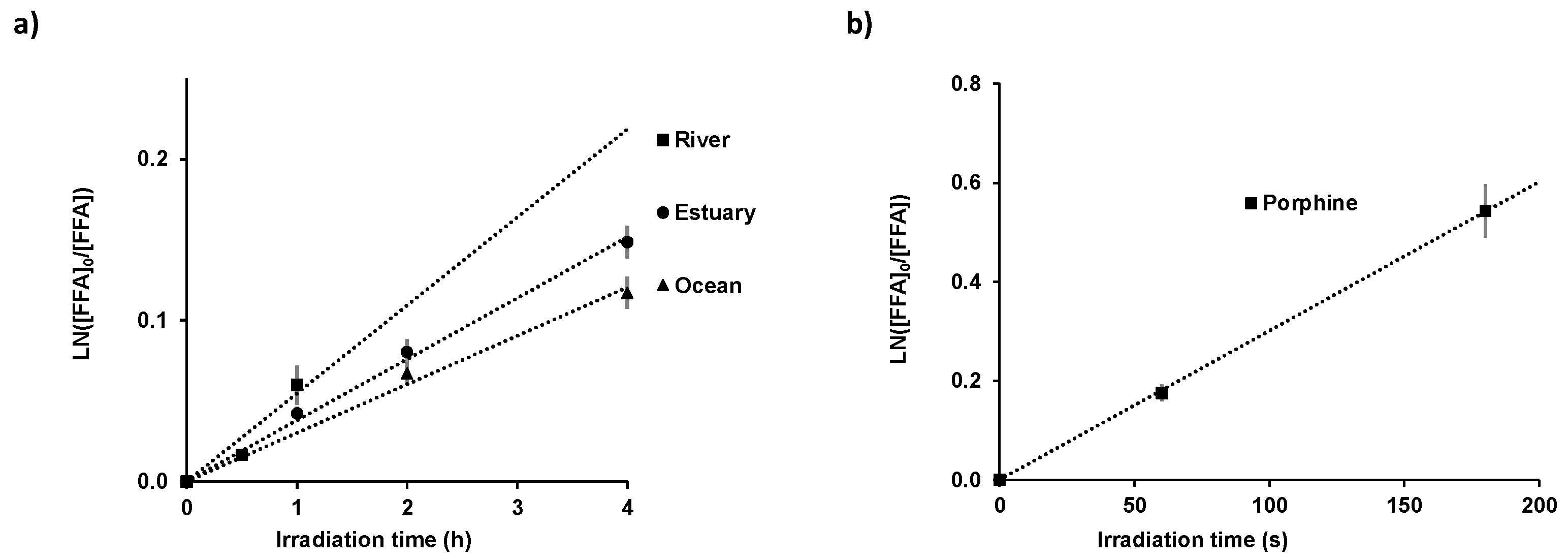




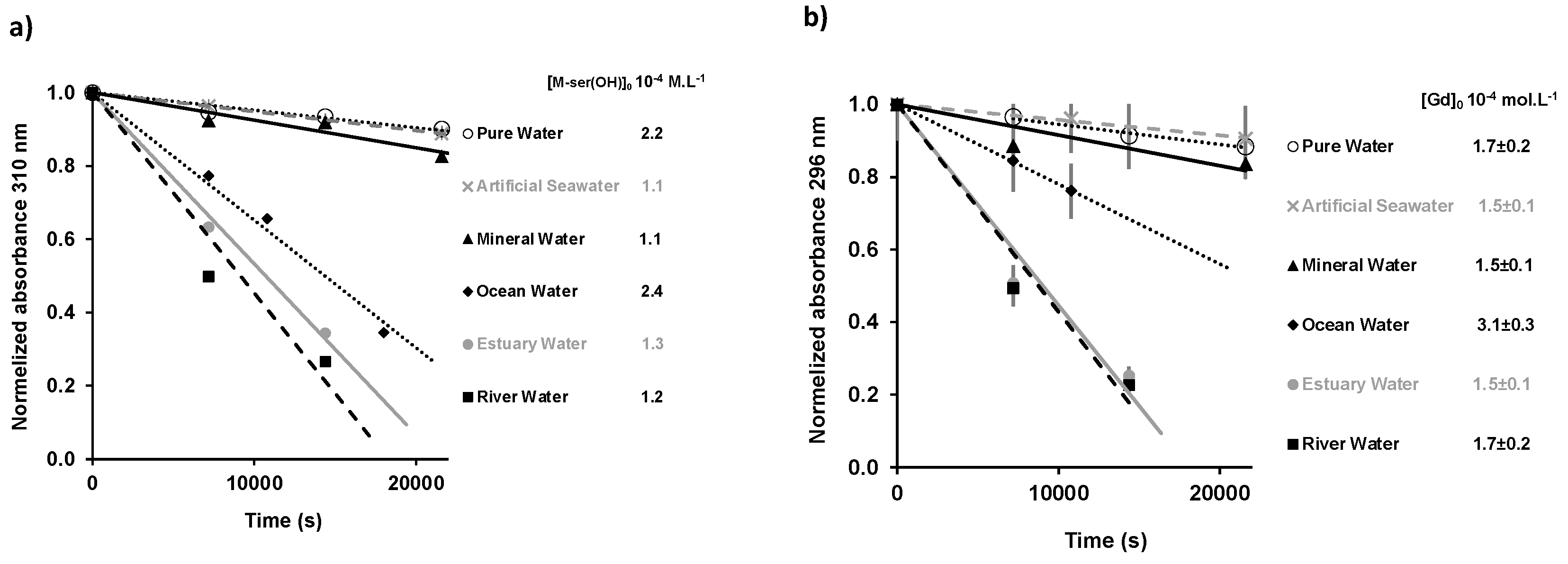
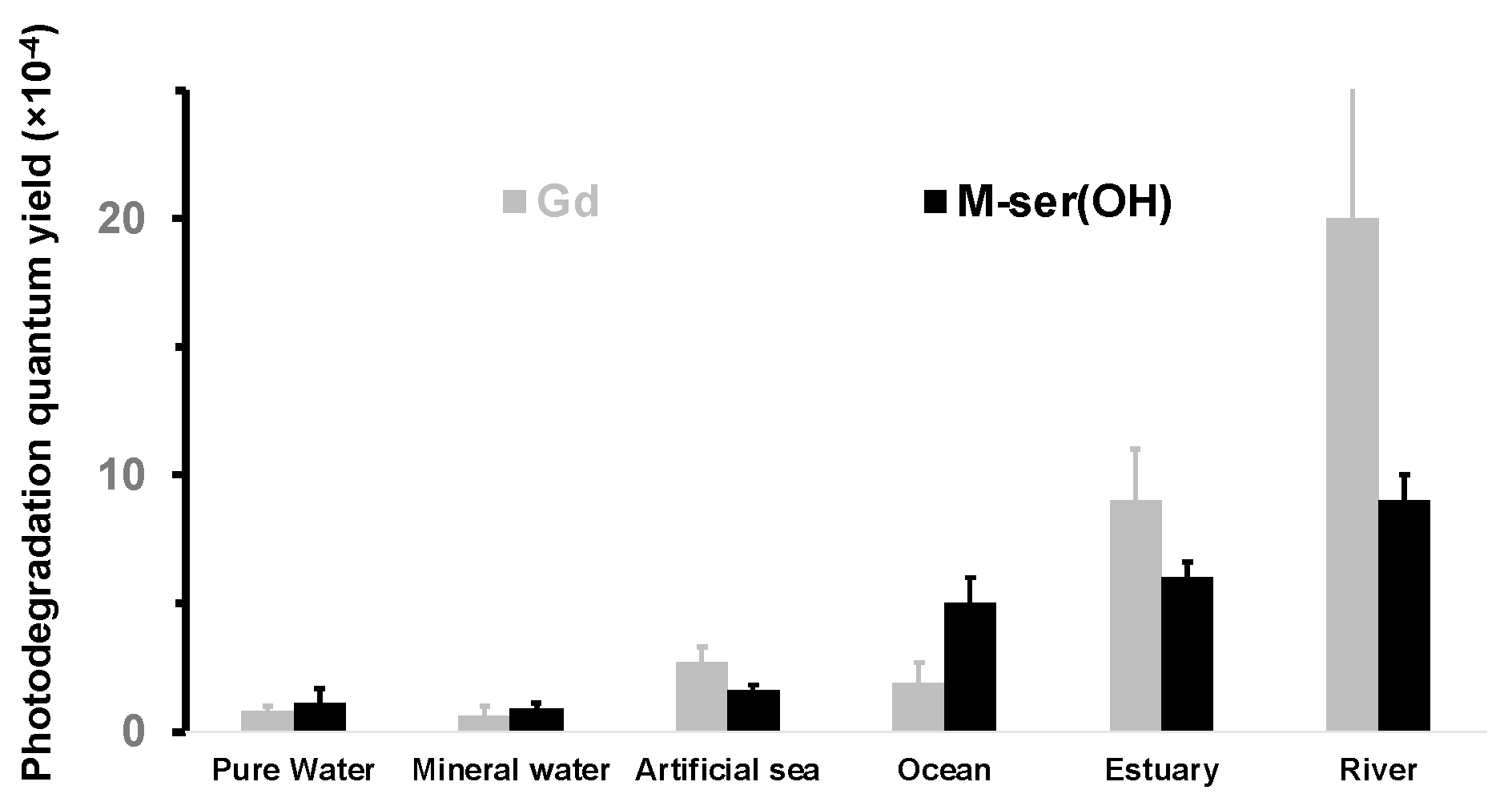

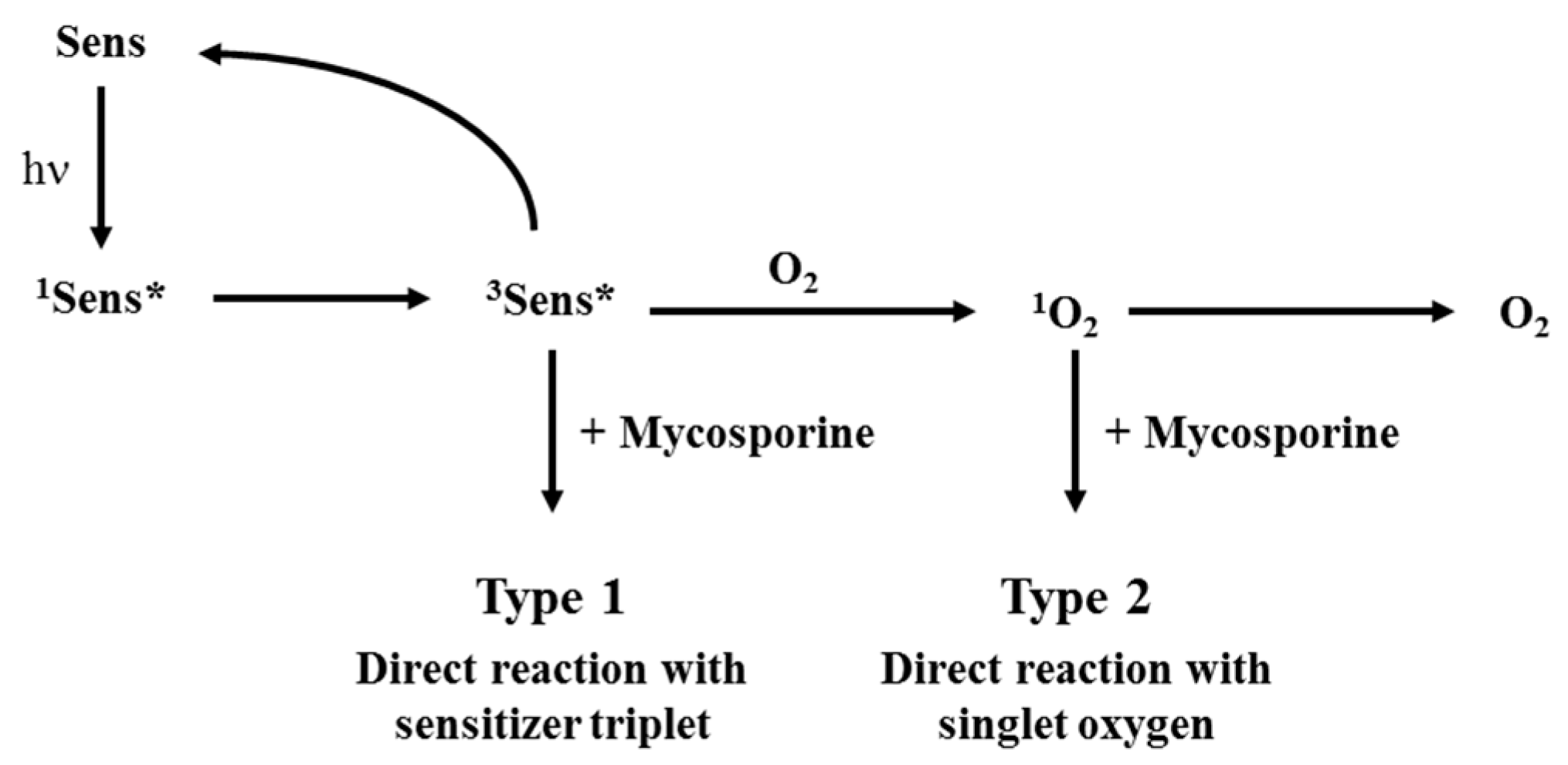
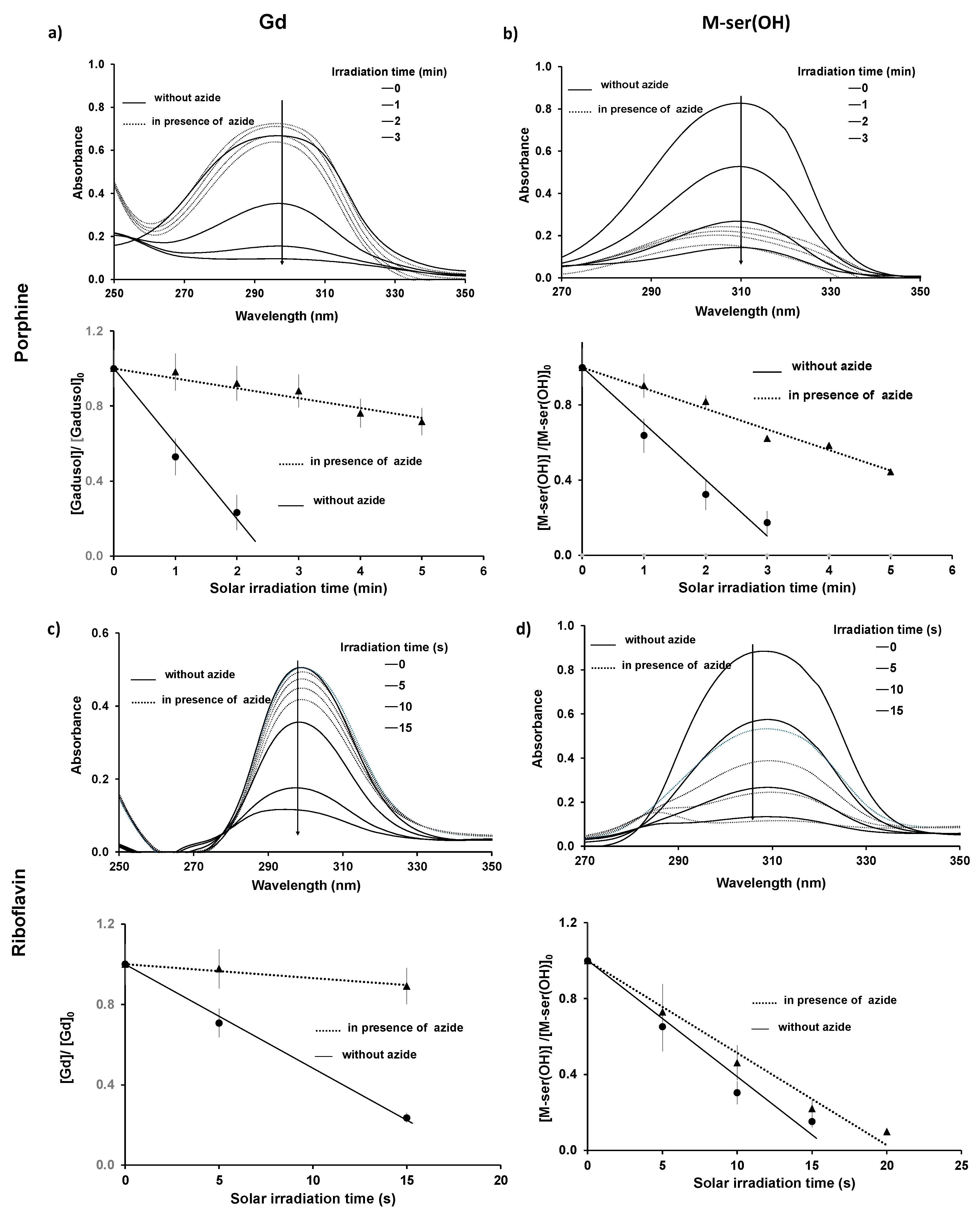
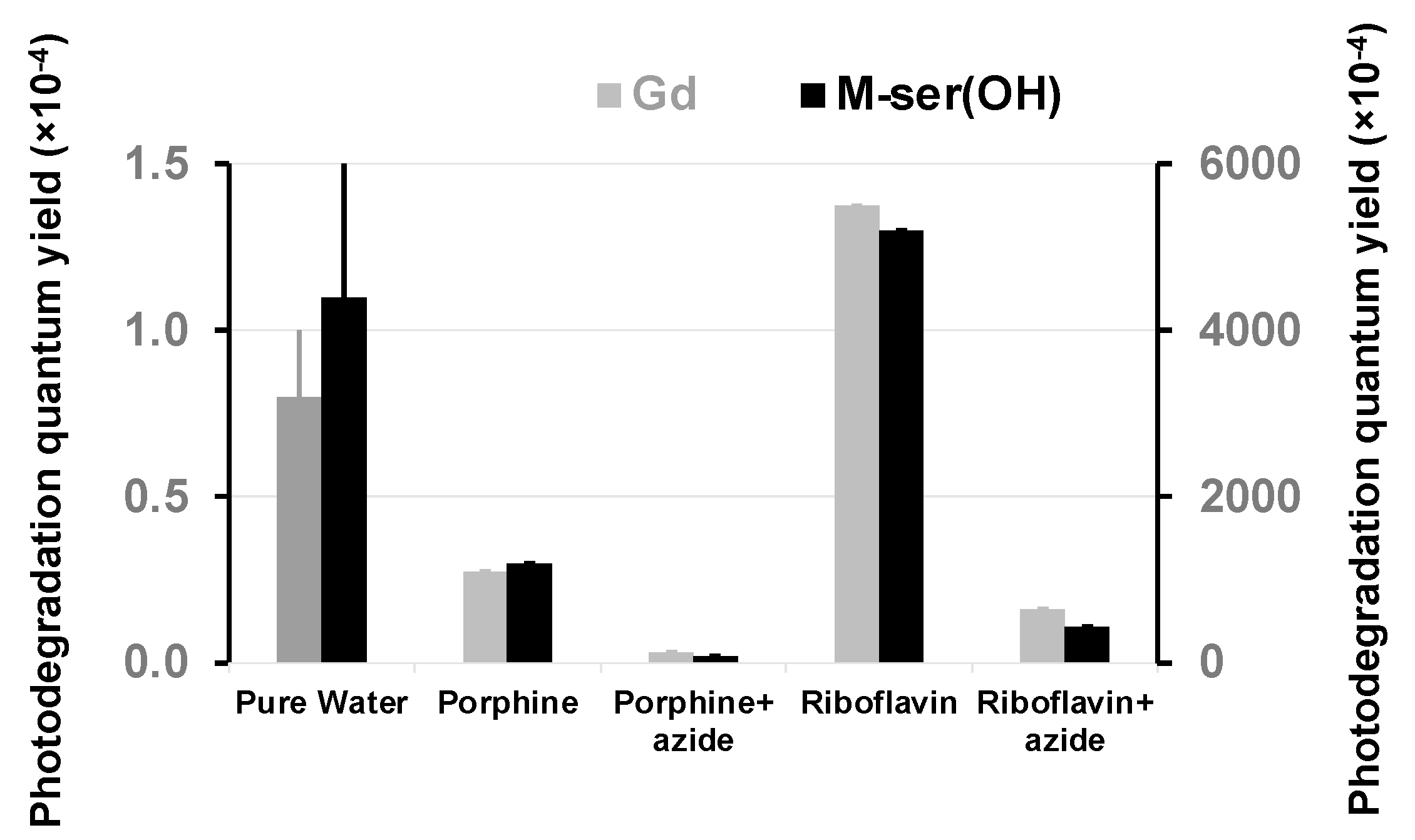
| Matrices | Total Irradiation Time (h) | kapp × 10−3 (s−1) | [1O2]ss × 10−11 (mol.L−1) |
|---|---|---|---|
| River Water | 1 | 0.015 ± 0.002 | 0.013 ± 0.001 |
| Estuary Water | 4 | 0.0105 ± 0.0002 | 0.0088 ± 0.0009 |
| Ocean Water | 0.00084 ± 0.0003 | 0.0070 ± 0.0007 | |
| Photosensitizer in pure water | Total Irradiation Time (s) | kapp × 10−3 (s−1) | [1O2]ss × 10−11 (mol.L−1) |
| Riboflavin | 60 | 9.3 ± 0.9 | 7.8 ± 0.8 |
| Porphine | 180 | 2.89 ± 0.02 | 2.4 ± 0.2 |
| Natural Compounds | Photodegradation Quantum Yield (Φ × 10−4) | ||||||||
|---|---|---|---|---|---|---|---|---|---|
| Pure Water | Mineral Water | Artificial Seawater | Ocean Water | Estuary Water | River Water | ||||
| Gadusolate | 0.8 ± 0.2 | 0.6 ± 0.4 | 2.7 ± 0.6 | 2.9 ± 0.8 | 9 ± 2 | 20 ± 6 | |||
| Porphine | Riboflavin | ||||||||
| without azide | with azide | without azide | with azide | ||||||
| 1100 ± 200 | 130 ± 30 | 5500 ± 1000 | 650 ± 100 | ||||||
| M-Serinol | 1.1 ± 0.6 | 0.9 ± 0.2 | 1.6 ± 0.2 | 5 ± 1 | 6.0 ± 0.6 | 9 ± 1 | |||
| Porphine | Riboflavin | ||||||||
| without azide | with azide | without azide | with azide | ||||||
| 1200 ± 200 | 140 ± 30 | 5200 ± 1000 | 440 ± 90 | ||||||
Disclaimer/Publisher’s Note: The statements, opinions and data contained in all publications are solely those of the individual author(s) and contributor(s) and not of MDPI and/or the editor(s). MDPI and/or the editor(s) disclaim responsibility for any injury to people or property resulting from any ideas, methods, instructions or products referred to in the content. |
© 2024 by the authors. Licensee MDPI, Basel, Switzerland. This article is an open access article distributed under the terms and conditions of the Creative Commons Attribution (CC BY) license (https://creativecommons.org/licenses/by/4.0/).
Share and Cite
Thomas, M.G.; Blanc, S.; Le Bechec, M.; Pigot, T.; C. M. Fernandes, S. Effect of Reactive Oxygen Species Photoproduced in Different Water Matrices on the Photostability of Gadusolate and Mycosporine-Serinol. Mar. Drugs 2024, 22, 473. https://doi.org/10.3390/md22100473
Thomas MG, Blanc S, Le Bechec M, Pigot T, C. M. Fernandes S. Effect of Reactive Oxygen Species Photoproduced in Different Water Matrices on the Photostability of Gadusolate and Mycosporine-Serinol. Marine Drugs. 2024; 22(10):473. https://doi.org/10.3390/md22100473
Chicago/Turabian StyleThomas, Martin George, Sylvie Blanc, Mickael Le Bechec, Thierry Pigot, and Susana C. M. Fernandes. 2024. "Effect of Reactive Oxygen Species Photoproduced in Different Water Matrices on the Photostability of Gadusolate and Mycosporine-Serinol" Marine Drugs 22, no. 10: 473. https://doi.org/10.3390/md22100473
APA StyleThomas, M. G., Blanc, S., Le Bechec, M., Pigot, T., & C. M. Fernandes, S. (2024). Effect of Reactive Oxygen Species Photoproduced in Different Water Matrices on the Photostability of Gadusolate and Mycosporine-Serinol. Marine Drugs, 22(10), 473. https://doi.org/10.3390/md22100473







